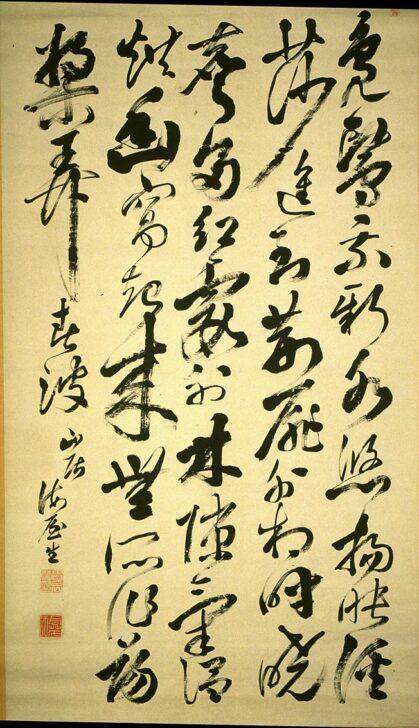Calligraphy: Watching Ducks on a Spring Morning
Nukina Kaioku

Description
Nukina Kaioku
Japan, 1778–1863
Calligraphy: Watching Ducks on a Spring Morning
Edo period (1615–1868)
ca. 1840–63
Hanging scroll, ink on paper
Museum purchase made possible by the Margaret Watson Parker Art
Collection Fund, 1987/2.45
Calligraphy was considered the quintessential art of the
East Asian scholar, revealing both the writer’s knowledge of
tradition and his own persona. By following each line of the
text, one can experience the movements of the artist’s brush,
arm, and body. Because nothing can be hidden or reworked,
the creative process seems to unfold before the eyes in real
time. In this monumental scroll, Nukina Kaioku, one of the
most influential calligraphers of his day, has brushed a Chinese
poem of his own composition on the theme of nature as a
refreshment for the spirit. Note his masterful variation of thick
and thin strokes, wet and dry ink, stately and rapid movement:
it is a supremely confident work, probably from the last two
decades of his life.
Subject Matter:
Calligraphy was considered the quintessential art of the East Asian scholar, as it reveals both the writer’s knowledge of tradition and his own persona. By following each line of text, we can visually and even kinesthetically experience the gestures of the artist’s brush, arm, and whole body. Because nothing is hidden or re-worked, the creative process seems to replay itself before our eyes in real time, with searing honesty. it is a supremely confident work, probably from the last two decades of his life.
Physical Description:
In this monumental scroll, Nukina Kaioku has brushed a Chinese poem of his own composition, on the enduring theme of nature as refreshment for the spirit. Note his masterful variation of thick and thin strokes, wet and dry ink, stately and rapid movement.
The verses may be tentatively rendered into English as follows:
Mandarin ducks enjoy the fresh water; their graceful forms glow as they pass through channels in the reeds.
Pushing beyond the thickets [to the open pond], they call to one another again and again in the dawn.
A crimson mist breaks through gaps in the glade, its glow warming hidden nests.
Waking up with nothing to do, [I came here] to playfully row among the spring waves.
Usage Rights:
If you are interested in using an image for a publication, please visit https://umma.umich.edu/request-image/ for more information and to fill out the online Image Rights and Reproductions Request Form.